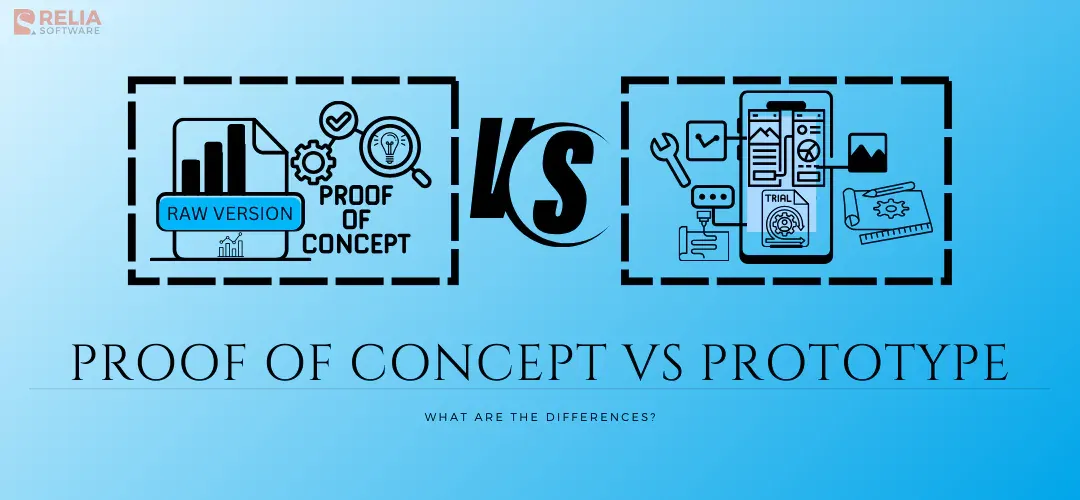Proof of concept and prototype are the building blocks of any successful digital product. Each term refers to a different step in the process, but together they help businesses make their dreams come true.
As we break down POC and prototypes, here you'll learn how they are different and the right phase to use these methods in business. It doesn't matter if you're a seasoned worker or a startup leader; these basics are very important in the beginning stages of getting your project off the ground. Let's check it out!
Understanding the Proof of Concept (POC)
The proof of concept (POC) is a rough drawing of a proposed real-world feature, crucial for ideation. You need a POC to persuade your employer or client. It helps them visualize the product or feature, sparking their imagination and your idea.
The proof of concept can be created using complex applications like Photoshop or Sketch to visualize ideas. Or else, using sticky notes or a whiteboard to display your ideas could be simpler.
Understanding the Prototype Model
Prototypes are tools that demonstrate a product, feature, or design's functionality in real life. A designer can show a product or feature's actual application, detail user experience (UX) design, or issues of software through a Prototype.
Imagine a prototype as a POC development but it is more refined, more like the final product, and encourages user testing. It lets you test your product or feature's functionality and find design flaws.
Creating a prototype may require software such as Axure or Framer which visualizes digital ideas. It might also use paper or Sketch to create a wireframe, which is then animated.
>> Read more:
- 12 Essential Technical & Soft Skills for UX Designers
- What is Prototype Testing? Methods & Testing Guide

Key Differences of Proof of Concept (POC) vs Prototype
While both proofs of concept (POC) and prototypes are useful in the early stages of software development, they serve different functions and have distinct qualities. Here's an overview of the main differences.
Purpose
Proof of Concept: The goal of proof of concept (POC) is to ensure that the main idea can work.
Prototype: This is a model that tests and shows how a possible product or system works, looks, and feels to the user. This is the answer to the question "What will the finished product look and do?"
Focus
Proof of Concept: Checks to see if an idea is technically possible and works in general. The point is the feasibility and showing that the product can be built.
Prototype: Focusing on design and user experience (UX). It helps to figure out how people will use the product and whether it meets their needs.
Stage
Proof of Concept: In the early steps of a project, proofs of concept (POC) are often made to see if the idea is worth developing further.
Prototype: Prototypes are made later, usually after a good proof of concept, to make the idea better and see it in action.
Functionality
Proof of Concept: Proofs of concept (POC) tend to have a smaller span and focus on a single, technical, or specific part of the idea.
Prototype: A prototype of a system or object can have more features, like design, functionality, and how the user interacts with it.
Fidelity
Proof of Concept: PoCs are generally low-fidelity and may not resemble the final result. They can test concepts rapidly with little development.
Prototype: Needed to be higher-fidelity and closely mirror the final product's functionality and design.
Development Time
Proof of Concept: A prototype was made quickly with few resources because it was just an experiment. It can be done in several days to 1-2 weeks.
Prototype: A prototype needs more time and money to make than a proof of concept (POC), but not as much as a full-fledged product.
Cost
Proof of Concept: Usually cheaper because it can be done quickly and do not need much effort.
Prototype: Because it is more complicated and interactive, it may cost more than a proof of concept.
User Engagement
Proof of Concept: Little or no user participation. The emphasis is on internal validation.
Prototype: Prototyping may include user testing to get feedback on functionality and ease of use.
Here is the summarization of the differences between proof of concept (POC) and prototypes.
|
Features |
Proof of Concept (POC) |
Prototype |
|
Focus |
Feasibility |
User experience (UX) design |
|
Purpose |
Check for feasibility |
Visualize the product work |
|
Stage |
Proving Ideas |
Design & development stage |
|
Functionality |
One feature only |
Multiple features |
|
Fidelity |
Low, not the same as the final |
High, closely resembles the final |
|
Development Time |
In a short period |
Need more time than POC |
|
Cost |
Cheaper |
More expensive |
|
User Engagement |
No need |
Requires some user involvement |
Typical Similarities of Proof of Concept (POC) and Prototype
While proof of concept (POC) and prototypes offer different functions in the software development procedure, they do have certain essential similarities:
Early Stage Exploration: POC and prototypes are employed in the initial phases of software development before full-scale production begins. They are instruments for testing and improving a concept before allocating considerable resources.
Reducing Risk: Both methods help to reduce the likelihood of creating a product that no one wants or that is not technically feasible. By giving early input and validation, they can save time and resources.
Iterative Process: An iterative process might include both proof of concept (POC) and prototypes. They can be developed, tested, and refined based on user feedback. This enables continual improvement of the product conception.
Communication Tool: Both proof of concept and prototypes can be utilized as communication tools. They can assist stakeholders, like investors or development team members, in visualizing the product concept and understanding its potential.
Building a Foundation: While POCs and prototypes have different aims, both help to establish the groundwork for the eventual product by detecting potential concerns and confirming fundamental features.

Proof of Concept vs Prototype: Which One Should You Choose?
Choosing a PoC or prototype is somehow difficult for businesses. Each has its use depending on the situation. Let's explore when to use each tool!
When To Use Proof of Concept (POC)?
A proof of concept is like a map legend, helping you evaluate a concept's feasibility before starting. It works well in these two cases:
1. When a concept's practicality is unknown
A proof of concept guides you when you're exploring new ground with an inventive idea. It lets you see if the idea is technologically possible before investing time and money in development.
2. When a solution must prove it can address a specific problem or meet a specific need
Proof of concept soothes stakeholders like scientific proof. It proves your solution can address the problem or meet demand, reducing doubt and generating faith in your idea.
When To Use Prototypes?
A prototype lets stakeholders interact with your product like a comprehensive map. Here are scenarios where you can use prototypes effectively.
1. When the product concept is validated
When your POC proves your idea is workable, bring out the prototype. Step from the drawing board to a real model to show stakeholders the product in greater detail.
2. When using input to improve the design
A prototype lets you get input and improve design, flow, and user experience before making the final product. This iterative process ensures your product resonates with your audience.
Conclusion
A proof of concept (POC) is ideal if you need to prove your concept's practicality or solve a specific problem. If your idea passed the feasibility test and you require a prototype to refine design and user experience, you need one. Knowing which tool to employ at each product development stage is critical.
Mastering the mechanics of effective and efficient product development requires understanding the differences between a proof of concept and a prototype. Hope that this blog helps you differentiate the proof of concept (POC) vs prototypes!
>>> Follow and Contact Relia Software for more information!
- Designing an application

